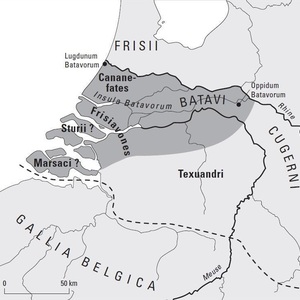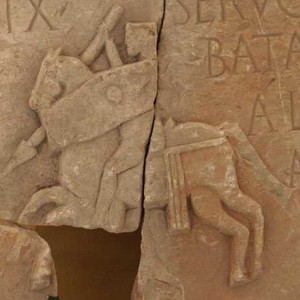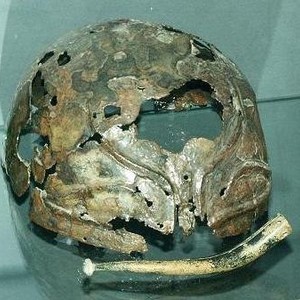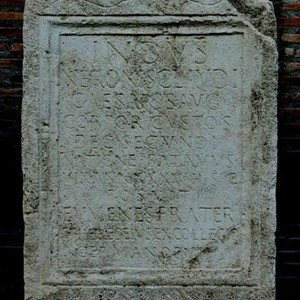Roman Auxilia - Cohors IX Batavorum
Cohors IX Batavorum was an auxiliary unit of the Roman Empire, composed of the Batavi tribe.
The Batavi were an ancient Germanic tribe that lived at the mouth of the Rhine, in the Roman province of Belgium (a Roman province established in 16 BC in the territory inhabited by the Celtic tribe of Belgae) - the territory of modern-day Netherlands.
From 12 AD, the Romans conquered the territories inhabited by the Batavi, and apart from the rebellion of 69-70 AD, the Batavi proved themselves to the Romans as brave and reliable warriors in the auxiliary units.
Roman emperors even included the Batavi for their superior military and cavalry skills in the Equites singulares - the personal horse guards of the emperor or the governor of the province. This unit consisted of 1000 riders. Their camp was located in Rome on the Caelian Hill (southeast part of Rome). They were abolished, like the praetorians, in 312 AD by the edict of Constantine the Great.
The historian Tacitus also wrote about the Batavi: "The Batavi, before their migration across the Rhine, formed part of the Chatti tribe; due to internal disputes, they moved to the most remote part of the Gallic coast, where there were no settled residents at that time, and also occupied a nearby island, washed by the Ocean in front, and by the Rhine from behind and from the side. Neither the wealth nor the power of Rome, nor alliances with other tribes have curtailed them, and they still supply the empire only with warriors and weapons."
Under the agreement with Rome, the Batavi did not pay the usual tribute, but instead were obliged to send their warriors to participate in Roman military campaigns at the command of the Roman leadership.
The Romans valued the Batavi. Their commanders were their local chiefs and aristocrats, unlike the rest of the cohorts and alae (cavalry units) of the auxiliaries, where the officers were Romans.
The functions of the Batavi in the Roman army were as follows: reconnaissance (they were excellent riders, capable of crossing rivers with their horses, even deep ones); messengers; during a battle, they would initiate the battles, pinning down the enemy and holding them, depriving them of maneuverability until the main forces of the legions approached, who, entering the battle, would finish the rout of the enemy; pursuit of the retreating enemy; fighting enemy cavalry (as they were armed with spears); protecting the rears and flanks of the legions.
Battle Path
- The Batavi participated in the Romans' Rhine campaigns in Germany from 12 to 17 AD.
- They also took part in the conquest of Britain in 43 AD under Emperor Claudius (41-54 AD) and served as rowers and sailors on the ships of the Rhine fleet.
- In addition, they served in the personal cavalry guard of the Roman emperors.
- According to historians' estimates, the Batavi put forward approximately 5 to 10 thousand people for service to Rome in the 1st century AD.
- The Batavi also took part in the civil war (the Year of the Four Emperors), which began after the death of Emperor Nero in 68 AD. In 69 AD, they supported the claimant to the Roman throne, Vitellius, fighting on his side in the battle with the forces of Emperor Otho at Bedriacum in April 69.
- One of the Batavi leaders named Julius Civilis, declaring support for another claimant to the imperial throne in Rome, Vespasian, raised the Batavi against Vitellius' supporters, but this rebellion eventually turned into a general Batavi uprising with the support of German tribes across the Rhine against Roman rule.
- The rebels in 70 managed to destroy the Roman military camps and the Roman troops stationed there in the province of Lower Germany. The Rhine fleet also supported the rebels, as a large part of its sailors were recruited from the Batavi.
- After the ascent to the throne of Emperor Vespasian (69-79 AD), the Romans moved a large number of forces to the Rhine, which were led by Quintus Petillius Cerialis. Cerialis was able to suppress the Batavi uprising and conquer their lands rather quickly.
- Most of the Batavi did not participate in the uprising, so the repressions directed by the Romans at the participants of the uprising did not touch them. All participants of the uprising, including its leader Civilis, were severely punished by the Romans.
- Later, the Romans resumed the practice of using the Batavi in their army. After this, the Batavi no longer rebelled and enjoyed all the privileges and benefits granted to them by Rome.
Related topics
List of Roman Legions, Cohors II Cantabrorum, Auxiliaries, Auxilary-hastat, Auxiliary-horseman
Literature
1. Jona Lendering, De randen van de aarde. De Romeinen tussen Schelde en Eems (2000).
2. Hans Teitler, De opstand der ‘Batavieren’ (1998).
3. Callies H., Neumann G. Bataver // Reallexikon der Germanischen Altertumskunde. Berlin/New York 1976, Bd. 2, S. 90–91.
4. Ihm M. Batavi. // Paulys Realencyclopädie der classischen Altertumswissenschaft. Stuttgart 1893, Bd. 3,1, S. 118–121. // de.wikisource.org
5. Roymans N. Ethnic Identity and Imperial Power: The Batavians in the Early Roman Empire. Amsterdam 2004.
6. Derks T. Ethnic identity in the Roman frontier. The epigraphy of Batavi and other Lower Rhine tribes. Ethnic Constructs in Antiquity: The Role of Power and Tradition. Ton Derks, Nico Roymans (ed.). Amsterdam: Amsterdam University Press, 2009. p. 239–282.
7. Speidel M. P. Swimming the Danube under Hadrian's eyes: A feat of the Emperor's Batavi horse guard // Ancient Society. 1991. Vol. 2. P. 277–282.
8. Speidel M. P. Riding for Caesar: The Roman Emperors’ Horse Guards. Cambridge, 1994.
9. Alföldy G. Die Hilfstruppen der römischen Provinz Germania inferior, Bonn 1968.
10. Willems, W.J.H., Romans and Batavians. A regional study in the Dutch Eastern River Area, II // Berichten van de Rijksdienst voor het Oudheidkundig Bodemonderzoek, 1984, Bd. 34, S. 39–331.
11. Nicolay J. Armed Batavians: Use and Significance of Weaponry and Horse Gear from Non-military Contexts in the Rhine Delta (50 BC to AD 450). Amsterdam: Amsterdam University Press, 2007, 424 p.






